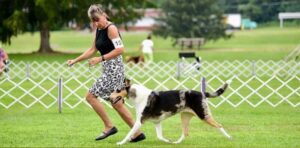
Interview with Breeder/Owner Handler Mara Flood
Interview with Breeder/Owner Handler Mara Flood. Mara shares her experiences as a Breeder/Owner Handler in the world of purebred dogs.

Home » Dog Breeds » Australian Cattle Dog
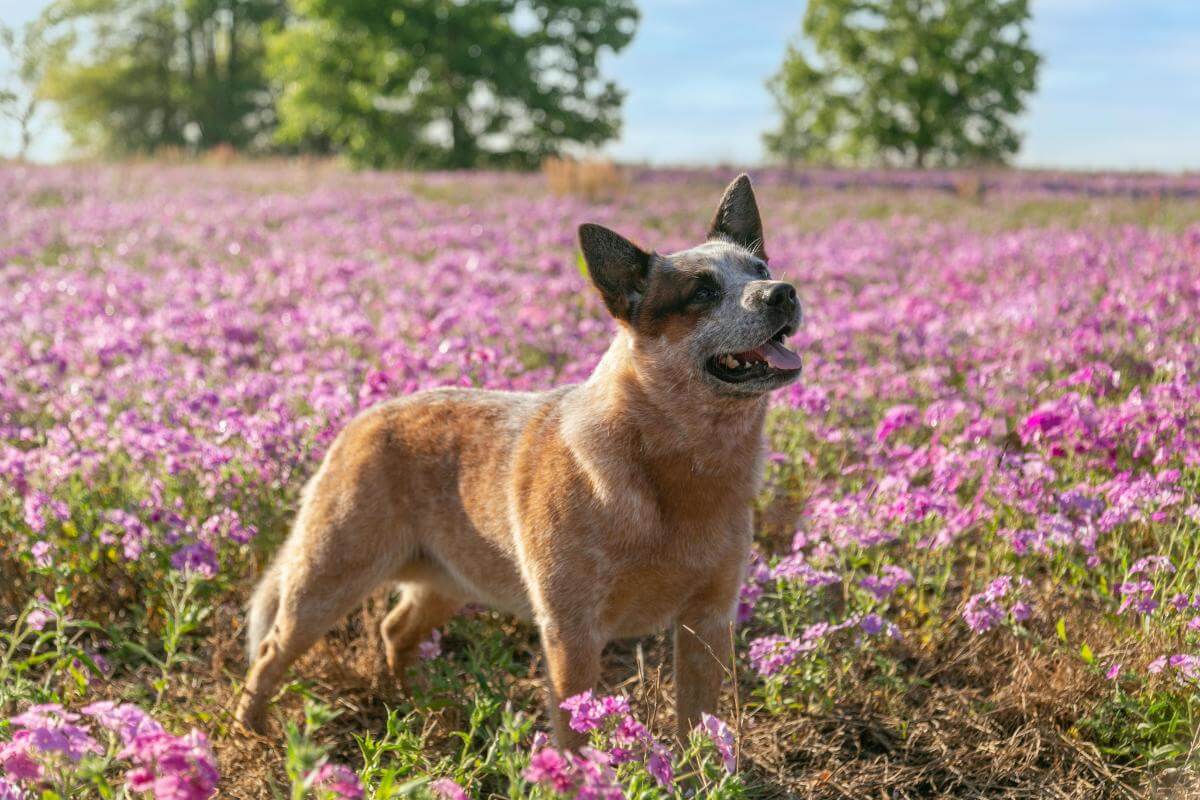
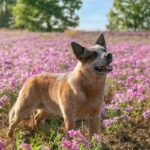
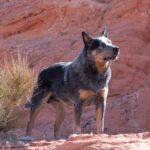
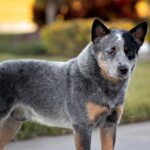
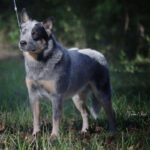
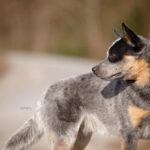
The Australian Cattle Dog, often simply known as the “Cattle Dog” or “Blue Heeler,” is a robust, active, and agile breed renowned for its herding prowess. Originally developed in Australia for driving cattle across long distances and rugged terrain, the breed is a perfect fusion of stamina, intelligence, and resilience.
Herding
17 – 20 inches
35 – 50 pounds
12 – 16 years
| Country of Origin | Australia |
|---|---|
| Bred For | Controlling and Moving Cattle, Companionship |
| Known For | Courage, Intelligence, Willingness to Work |
| Popularity | High |
| Temperament | Loyal, Protective |
| Activities | Herding, Hiking, Running, Farm Dog, Conformation Shows, Dog Sports |
The Australian Cattle Dog, sometimes affectionately known as the “Blue Heeler” or “Queensland Heeler,” boasts a rich history that is deeply intertwined with the development and expansion of the Australian agricultural industry.
In the early 19th century, as European settlers began to establish cattle farms in the harsh Australian Outback, they soon realized that the traditional herding dogs they had brought with them from England were not ideally suited to the challenging conditions of Australia. The vast landscapes, extreme climate, and resilient cattle required a particular kind of herding dog that was agile, enduring, and intelligent.
To address this need, settlers began experimenting with crossbreeding. The initial cross involved a native Australian dog, the Dingo, and the smooth-coated blue merle Collies that settlers had brought with them. This produced a hardy and resilient dog, but further refinements were still needed.
Subsequent crossings introduced breeds like the Dalmatian, which added loyalty and a good rapport with horses, and the Black and Tan Kelpie, which enhanced the dog’s herding instincts. The resultant dog was a tireless worker, able to handle the tough cattle as well as moving easily through the vast territories. The dog that was developed became what we recognize today as the Australian Cattle Dog.
As the breed’s reputation grew, it began to gain recognition from canine organizations. The Australian Cattle Dog was officially recognized by the American Kennel Club (AKC) in 1980. The Fédération Cynologique Internationale (FCI) and The Royal Kennel Club (UK) also granted the breed official recognition, further cementing its status as a separate breed within the dog world.
The breed’s history is a testament to the power of selective breeding and to the adaptability of the domestic dog. From the challenges of the Outback to the show rings of the world, this breed has reliably showcased its versatility, intelligence, and unparalleled work ethic with ease.
Adult male Australian Cattle Dogs typically stand between 18 and 20 inches tall at the shoulder, while mature females generally measure between 17 and 19 inches. Males usually weigh in the range of 35 to 50 pounds, with females slightly lighter, averaging between 30 to 45 pounds.
The Australian Cattle Dog is a balanced and sturdy working dog, exhibiting both power and agility. When viewed from the side, the body’s length, from the point of the shoulder to the rear point of the pelvis, is slightly longer than the height at the withers. This provides these dogs with a ground-covering stride that is essential for a hard-working herder. Substance-wise, the Cattle Dog possesses strong bone, and its muscular body gives these dogs the strength to control and move stubborn livestock.
Texture: The Australian Cattle Dog has a smooth and hard coat which lies flat against the body. The breed typically has a dense undercoat that provides protection against extreme weather conditions. The outer coat’s texture is invariably straight and is neither too long nor too short in length. The double coat is short on the head, fronts of the legs, and on the feet. It is longer and thicker on the neck, and somewhat longer under the body where it presents a mild form of breeching near the thighs.
| Standard Color | |
|---|---|
| Blue | ee |
| Blue Mottled | ee |
| Blue Speckled | ee |
| Red Speckled | ee |
| Red Mottled | ee |
A Note About Color: Overall color is either blue or red. Blue dogs may be blue, blue-mottled, or blue speckled, with or without other markings. Permissible markings are black, blue, or tan markings on the head which are evenly distributed. Red dogs have even red speckles all over, with or without darker red markings on the head. Black and red markings on the body are not desirable in Blue and Red Cattle Dogs respectively.
| Standard Marking | |
|---|---|
| Tan Markings | ee |
| Red Markings | ee |
| Black & Tan Markings | ee |
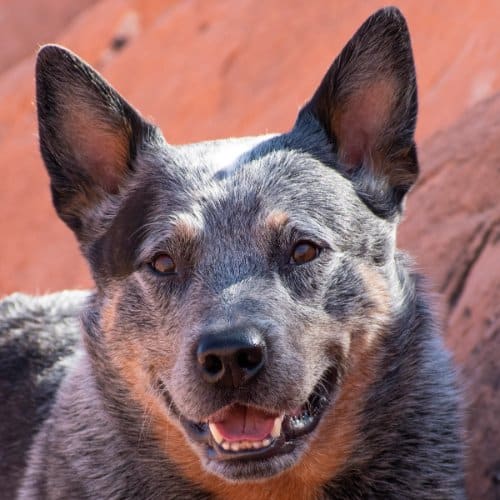
The tail is of moderate length, reaching approximately to the hock when the dog is in a relaxed position. It is set moderately low, following the line of the spine at the base. The tail broadens and is well-covered with hair, especially on the underside where it forms a “good brush.”
When the dog is attentive or moving, the tail may be raised, but it should never curl over the back. Instead, it is carried with a very slight upward curve. When the dog is at work, the tail is often seen in a lowered position, displaying the breed’s intense focus and purpose.
The tail serves as a kind of rudder, aiding in balance and agility, especially when making quick turns during herding activities. In some regions, or under very specific working conditions, the tail of this breed has been docked, although the practice is largely a thing of the past.
The Australian Cattle Dog, often recognized for its remarkable herding instincts, intelligence, and energy, is a loyal and hardworking purebred. As with any dog breed, there are several factors which potential owners should consider before bringing one of these dogs home. From understanding its unique personality to catering to its health needs, being prepared will only enhance the experience with this wonderful breed.
The Australian Cattle Dog is a robust and healthy breed, known for its endurance and stamina. This dedicated and willing worker benefits greatly from regular check-ups with a veterinarian to ensure the dog remains in peak condition.
Lifespan: On average, the Australian Cattle Dog has a lifespan of 12 to 16 years. Proper care, nutrition, and regular vet visits can help to ensure it will live a long and healthy life.
Australian Cattle Dogs, while generally robust and hearty, are not exempt from certain health concerns that affect purebred dogs and mixed breeds alike. Here are some issues that may be encountered in the breed:
The Australian Cattle Dog is an incredibly dynamic breed, both in terms of intelligence and temperament. Known for its courage, determination, and natural herding instincts, this breed has won the admiration of many dog enthusiasts worldwide.
Being originally bred for herding cattle, the Australian Cattle Dog possesses an inherent work ethic. The breed’s drive, combined with an innate intelligence, can make these dogs both a joy and a challenge. Their sharp minds mean they pick up on training quickly, but it also means they can easily become bored if not mentally stimulated.
This breed might not be the best fit for novice dog owners. The Cattle Dog’s independent nature and strong-willed temperament require an owner who understands dog behaviors and is consistent with training.
In terms of sensitivity, they form strong bonds with their families. They can be wary of strangers but are usually not aggressive without cause. It’s essential to socialize them from a young age to ensure they’re comfortable around unfamiliar faces and situations.
When it comes to the breed’s interactions with other animals, its herding instincts might come into play. Cattle Dogs may attempt to herd other pets or even small children. While generally good with other dogs, early socialization is beneficial to prevent any potential dominance issues.
As for young children, while many Australian Cattle Dogs live harmoniously with kids, their herding tendencies can sometimes lead to nipping at the little one’s heels. It’s vital to teach children how to approach and touch dogs and to always supervise any interactions between dogs and young kids.
When it comes to feeding an Australian Cattle Dog, considering the breed’s unique nutritional needs is paramount. These dogs are highly active and require a diet that can support their energy levels and their muscle health.
For Australian Cattle Dog puppies, high-quality puppy food is recommended to support their rapid growth and development. Puppies have different nutritional requirements than adults, so it’s crucial to ensure they’re getting the right nutrients in the right amounts. Typically, feeding them 3-4 times a day will support their smaller stomachs and high energy levels.
As the Australian Cattle Dog transitions to adulthood, its dietary needs change. Adults typically do well on a high-quality adult dog food that caters to active breeds. When determining the amount of food, it’s essential to consider the dog’s age, activity level, and health status. On average, an active adult Australian Cattle Dog may require about 1.5 to 2.5 cups of dry dog food daily, divided into two meals.
It’s worth noting that every dog is an individual, and the optimal amount of food can vary based on factors such as metabolism, age, activity level, and health. Regularly monitoring a dog’s weight and adjusting portions as necessary can help to prevent obesity, a condition which can lead to various health issues.
Always ensure fresh, clean water is available at all times. Additionally, when considering treats or human food, it’s crucial to be aware of foods that might be harmful to dogs. Regular vet check-ups and consultations about diet can ensure the Australian Cattle Dog remains in peak health throughout its life.
Training an Australian Cattle Dog is a unique experience that requires understanding the breed’s inherent behavioral traits. These dogs are known for their intelligence, determination, and at times, their independent nature. While they are quick learners, this independence might require trainers to employ varied and innovative training methods to keep them engaged. Using positive reinforcement techniques, such as treats and praises, usually offers the most favorable outcomes.
Although Australian Cattle Dogs aren’t recognized for excessive barking, they are alert animals and will certainly notify their owners of any unusual activities or potential dangers around them. Teaching them a “quiet” command can help to manage their vocalizations and prevent unnecessary disturbances.
Their keen intelligence, combined with a strong work ethic, means they are most content when given tasks or challenges to tackle. Mental activities are as vital for this breed as physical exercises, ensuring they remain engaged and satisfied.
Regarding their inclination to wander, the breed’s natural instincts and curiosity can lead them to explore beyond their boundaries. It’s essential to provide a secure environment, like proper fencing, and ensure they are supervised during outdoor activities to prevent them from wandering off.
Lastly, stemming from their herding background, they possess a heightened prey drive. This inherent trait might compel them to chase after smaller animals. While training can help to control this instinct to an extent, potential owners should be mindful of it, especially if other smaller pets share the household.
The Australian Cattle Dog is a breed brimming with energy and stamina, thanks to its roots as a cattle herder. Meeting the breed’s exercise needs is essential for both its physical health and mental well-being.
| Energy Level | High |
|---|---|
| Exercise Requirements | 2 Hours/Day (Minimum), Daily Walks, Vigorous Running, Regular Exercise, Playing with Another Dog, Mental Stimulation |
One of the defining traits of this breed is its high energy level. This means that merely taking a Cattle Dog for a short walk around the block might not suffice. Longer, brisk walks, coupled with regular play sessions or fetch games, can help to keep these dogs content and burn off any pent-up energy.
In terms of intensity, the Australian Cattle Dog is no couch potato. The breed thrives on vigorous activities, and its robust nature allows it to engage in more strenuous exercises compared to some other breeds. Activities like hiking, running, or agility courses are particularly well-suited for this breed.
The Cattle Dog’s inherent playfulness is another aspect to embrace. Interactive toys, puzzle games, and regular play sessions can provide both physical and mental stimulation, which is crucial for such an intelligent breed.
However, it’s essential to remember that while the Australian Cattle Dog is a sturdy and resilient dog, like any breed, it can be prone to overexertion or heat-related issues, especially in hotter climates. It’s important to monitor these dogs during intense activities and ensure they have easy access to fresh water and shade as needed.
Australian Cattle Dogs come with a coat that’s both functional and relatively easy to maintain. However, even with their straightforward grooming needs, there are still aspects that owners should be aware of to keep the dog looking its best and feeling comfortable.
| Coat Type | Smooth, Short Undercoat, Straight, Hard, Rain-Resistant |
|---|---|
| Grooming Requirements | Weekly Brushing, Occasional Bathing, Routine Ear Cleaning, Periodic Nail Trimming, Regular Tooth Brushing |
The coat of an Australian Cattle Dog is dense and can protect it from various weather conditions. This breed goes through shedding periods, typically once or twice a year. During these times, regular brushing, preferably several times a week, can help to remove the dead hair and reduce the amount of hair that ends up around the house. Outside of their shedding seasons, a weekly brushing is usually sufficient to keep the dog’s coat healthy and free of debris.
While they aren’t heavy shedders year-round, Cattle Dog’s do shed consistently. Regular grooming not only helps to manage this shedding but also distributes the natural oils in the coat, keeping it shiny and healthy.
Bathing is required occasionally, typically when the dog gets particularly dirty or begins to emit an odor. Due to the natural dirt-repelling qualities of their coat, Australian Cattle Dogs generally stay cleaner than some other breeds.
Regular check-ups should also be part of the Australian Cattle Dog’s grooming routine. This includes checking ears for signs of infection or wax buildup, trimming nails if they don’t naturally wear down, and brushing teeth to prevent problematic dental issues.
Australian Cattle Dogs, known for their hard-working heritage, resilience, and intelligence, bring a distinctive dynamism to any household. Living with one is both a reward and a responsibility, given the breed’s unique temperament and exercise needs.
Given their active nature, one might assume that Australian Cattle Dogs are not suited for apartment living. However, while they thrive in spacious environments with room to roam, they can adapt to apartment life if they receive sufficient exercise and mental stimulation. The key is ensuring they have regular outings and activities that challenge both their body and mind.
Climate is another consideration. Australian Cattle Dogs are hardy creatures, with their dense coat providing some level of protection against both cold and hot weather. They can fare well in colder climates, though care should be taken during extremely frosty conditions. In contrast, while they can manage well enough in warmer temperatures, it’s crucial to offer shade, plenty of water, and avoid excessive exercise during periods of peak heat to prevent any heat-related ailments from occurring.
Australian Cattle Dogs are also known for their loyalty and protective nature. This means they can be wary of strangers, making early socialization crucial. Proper introductions and consistent exposure to varied environments and people can ensure they are well-adjusted and sociable in most settings.
The charm and exuberance of Australian Cattle Dog puppies are undeniable. These little bundles of energy, with their keen eyes and playful antics, can quickly steal the heart of any dog lover. However, raising an Australian Cattle Dog puppy requires dedication, understanding, and patience, given the breed’s inherent traits and needs.
From the moment they arrive home, Australian Cattle Dog puppies need a structured environment in order to thrive. Their early days should focus on building a foundation for their future, ensuring they grow into well-adjusted adults.
Socialization is paramount. Exposing puppies to various sights, sounds, environments, people, and other animals during their formative weeks can help to curb potential wariness or aggressive tendencies. Positive experiences during this period can shape their temperament and ensure they’re adaptable and confident in diverse settings.
Nutrition plays a pivotal role during the puppy stage. Feeding them high-quality puppy food ensures they receive the necessary nutrients to support their growth and development. It’s essential to follow recommended feeding guidelines, adjusting portions as they grow to prevent overfeeding and associated health issues.
Training should start early. Given the breed’s intelligence and sometimes independent nature, consistent, positive-reinforcement-based training from a young age can instill good habits and discourage undesirable behaviors. Basic commands like “sit,” “stay,” and “cone” are vital initial focuses.
Physical health is another area of attention. Regular vet check-ups, vaccinations, worming, and flea prevention will keep the puppy in optimal health, ensuring it is protected against common canine ailments.
Lastly, play and interaction are vital for their emotional well-being. Regular play sessions, bonding activities, and gentle introductions to basic games can strengthen the bond between the puppy and its people.
The Australian Cattle Dog is a breed characterized by its high energy, agility, and drive, making it particularly well-suited for a range of activities and dog sports. Engaging in these activities not only provides the necessary physical exercise but also offers mental stimulation, crucial for such an intelligent and active breed.
The Australian Cattle Dog is recognized by the world’s leading registries and kennel organizations, which categorize the breed into a specific Group based on its unique characteristics. This breed is recognized worldwide under the following Group designations:
| Organization | Group Designation |
|---|---|
| AKC (American Kennel Club) | Herding |
| UKC (United Kennel Club) | Herding Dog |
| CKC (Canadian Kennel Club) | Herding |
| ANKC (Australian National Kennel Council) | Working Dogs |
| RKC (The Royal Kennel Club) | Pastoral |
| FCI (Fédération Cynologique Internationale) | Group 1: Sheepdogs and Cattledogs Section 2: Cattledogs |
The ideal Australian Cattle Dog is described by a Breed Standard that is approved by each of the world’s leading registries and kennel organizations. The Breed Standards for this breed may be found in the following links:
| Organization | Breed Standard |
|---|---|
| American Kennel Club | AKC Australian Cattle Dog Breed Standard |
| United Kennel Club | UKC Australian Cattle Dog Breed Standard |
| Canadian Kennel Club | CKC Australian Cattle Dog Breed Standard |
| Australian National Kennel Council | ANKC Australian Cattle Dog Breed Standard |
| The Royal Kennel Club | RKC Australian Cattle Dog Breed Standard |
| Fédération Cynologique Internationale | FCI Australian Cattle Dog Breed Standard |
Breed clubs play an essential role in maintaining the Breed Standards as well as the purity and overall welfare of specific breeds. For the Australian Cattle Dog, these clubs serve as a hub for enthusiasts, breeders, and owners to come together, share knowledge, and champion the breed’s legacy.
In the United States, the primary breed club is the Australian Cattle Dog Club of America (ACDCA). Founded in 2004, with the mission to preserve the breed’s integrity and history, the ACDCA holds various events, offers educational resources, and advocates for responsible breeding and ownership.
In Canada, the Australian Cattle Dog Club of Canada (ACDCC) is the recognized national club. Similar to its American counterpart, the ACDCC works diligently to provide resources, conduct events, and foster a community of Australian Cattle Dog lovers throughout the country.
In the United Kingdom, the Australian Cattle Dog Society of Great Britain has represented the breed since its establishment in 1985. The organization plays an instrumental role in overseeing the Breed Standard, organizing events, and serving as a comprehensive resource for both newcomers and seasoned enthusiasts of the Australian Cattle Dog.
The commitment to the Australian Cattle Dog extends beyond breed clubs and encompasses organizations dedicated to the rescue and rehoming of these spirited canines. Rescue groups play a vital role in ensuring that Australian Cattle Dogs in need receive care, love, and, ultimately, a second chance at a happy life.
In the US, the Australian Cattle Dog Rescue Association (ACDRA), founded in 2008, stands out as a significant force for the welfare of the breed. Driven by a dedicated team of volunteers, ACDRA is committed to rescuing, rehabilitating, and rehoming Australian Cattle Dogs.
In the United Kingdom, while there might not be a breed-specific rescue solely for Australian Cattle Dogs, various all-breed rescues and organizations may occasionally have one of these dogs available for adoption.
Yes, Australian Cattle Dogs shed. These dogs possess a double coat that undergoes a shedding process usually once or twice a year. Regular grooming can help to manage and reduce the amount of loose hair around the house.
Australian Cattle Dogs have a life expectancy of 12 to 16 years. With proper care and a healthy lifestyle, it’s not uncommon for them to live even longer. In fact, one Australian Cattle Dog named “Bluey” lived for 29 years and 5 months and is recognized as one of the oldest dogs ever recorded.
Males typically stand between 18 to 20 inches at the shoulder, while females generally measure between 17 to 19 inches. The breed usually weighs in the range of 35 to 50 pounds, with females being slightly lighter than their male counterparts.
Australian Cattle Dogs are not inherently aggressive. They are, however, bred to be herding dogs, which means they can be very protective and assertive. Proper training and socialization from a young age are crucial to ensure they interact well with other animals and people. Like all breeds, individual temperament can vary, so it’s essential to consider each dog on a case-by-case basis.
Yes, Australian Cattle Dogs can make excellent family dogs when properly trained and socialized. They are loyal, intelligent, and often form strong bonds with their families. However, due to their high energy and herding instincts, it’s important to supervise interactions with young children and teach kids how to interact with any dog appropriately.
No, Australian Cattle Dogs are not considered hypoallergenic. They have a double coat and they shed, which can trigger allergies in sensitive individuals. Potential owners with allergies should spend time with the breed before deciding to ensure they don’t have a reaction.
Australian Cattle Dogs can coexist peacefully with cats, especially if they are introduced to them at a young age and are properly socialized. However, their herding instinct can sometimes prompt them to “herd” or chase cats. It’s always a good idea to supervise initial interactions and train the dog to behave appropriately around feline friends.
Yes! Australian Cattle Dogs are renowned for their intelligence. Bred to work and herd cattle in challenging Australian conditions, these dogs possess a sharp mind, keen problem-solving abilities, and a quick learning aptitude. Their intelligence, combined with their high energy levels, means they thrive when given tasks, training, and plenty of mental stimulation.

Interview with Breeder/Owner Handler Mara Flood. Mara shares her experiences as a Breeder/Owner Handler in the world of purebred dogs.
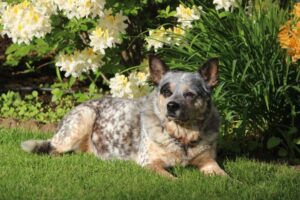
Interview with Herding Group Breeder Patti Salladay – My husband, Michael, and I reside in Portland, Oregon. I have been involved in the
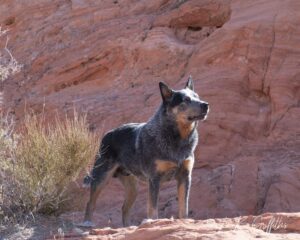
Are Australian Cattle Dogs Right for You? When the great grazing lands of Australia opened to settlers during the 1800s, necessity compelled
The best way to ensure a long and happy relationship with a purebred dog is to purchase one from a responsible breeder. Not sure where to begin?
Contact the National Parent Club’s Breeder Referral Program, which is listed on the AKC Breeder Referral Contacts page.
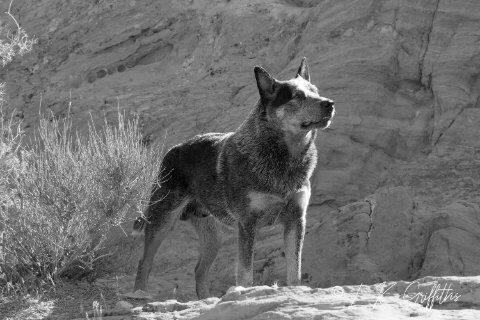

"*" indicates required fields
Showsight Magazine–the world’s most influential purebred dog publication since 1992. Each issue reaches a global audience dedicated to preserving the history and health of purpose bred dogs. Filled with award-winning editorial focused on news and insights from the dog show community, top breeders, handlers, AKC Judges, and more!